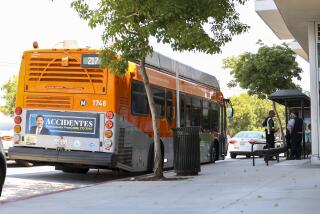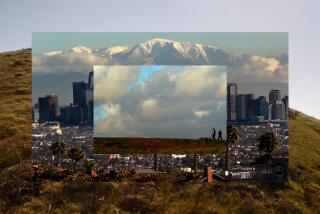Santa Clarita / Antelope Valley : Santa Clarita’s Newest Trail Offers Best of Both Worlds : Outdoors: Four-mile South Fork route is the first phase in a planned 25-mile network joining four communities.
- Share via
SANTA CLARITA — Like the city itself, Santa Clarita’s new South Fork Trail mixes rural calm with urban bustle.
Eight pairs of electrical towers loom over the length of the trail’s eastern side, while the Santa Clara River, now dry, runs along the western edge. Birds chirping from nearby trees compete with the steady drone of traffic along the not-too-distant San Fernando Road.
Bracketed by faded green posts, a 16-foot-wide asphalt track has been laid down for pedestrians and bicyclists.
The four-mile trail, near Magic Mountain Parkway and San Fernando Road, parallels the southern fork of the river, and is the first link in a planned 25-mile web joining Santa Clarita’s four communities.
City officials have scheduled a grand opening of a two-mile segment at 9:30 a.m. Saturday, although the South Fork route has been used by the public since construction began in October.
“It’s impossible to keep people out of here now,” said contractor Scott Evans, watching from his pickup truck as a bicyclist and his dog followed the equestrian trail for nearly a mile, then followed an outlet path into the back of a nearby Valencia community.
Crews from the Santa Clarita-based Evans & Sons Inc. worked along the path Thursday, installing posts and fencing along its southernmost end.
An additional half a mile of the trail will open within 60 to 90 days, with the remainder to open within a year, according to Joe Inch, Santa Clarita’s trail coordinator.
Cost of constructing the entire trail is projected at $350,000, with Santa Clarita using $150,000 in grant funds from the Los Angeles County Transportation Commission and $200,000 set aside by the Transportation Development Act.
The South Fork Trail serves Valencia and Newhall. A similar thoroughfare usable by pedestrians, bicyclists and equestrians is planned along Bouquet Canyon Road for Saugus and runs parallel to the main route of the Santa Clara River for Canyon Country.
“When you’re designing a bicycle corridor or an alternate transportation corridor, you like to include everyone you can,” Inch said. “Your primary goal is to get everyone to their destination.”
Some avid bicyclists believe the trail, by trying to serve a variety of people, won’t be frequented by serious riders.
“Any path that uses the phrase multiuse makes me shiver,” said John Lukes, director of the Human-Powered Transit Assn. that promotes bicycling.
More bicycle-related accidents occur on designated bicycle lanes than on unmarked surface streets, Lukes said.
“I think it’s a good recreational bike path--it’s off the road and everything,” said Lukes, who also serves on Santa Clarita’s Citizens Transportation Advisory Committee. “As a commuter bike path, it’s not very good.”
Rick Putnam, director of parks and recreation for Santa Clarita, said the 25-mile trail network will be operational within three to five years and cost $8.2 million.
More to Read
Sign up for Essential California
The most important California stories and recommendations in your inbox every morning.
You may occasionally receive promotional content from the Los Angeles Times.










